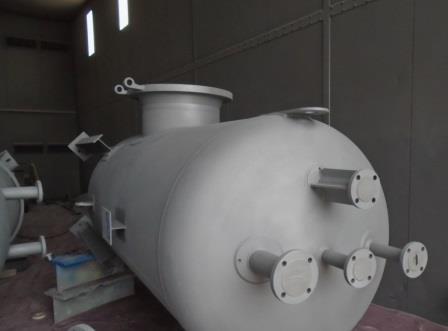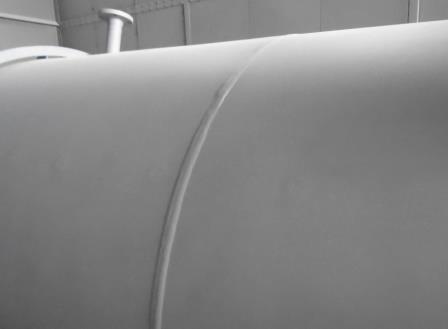SSPC-SP 5 White Metal Blast Cleaning (NACE No. 1)
SSPC-SP 5 White Metal Blast Cleaning (NACE No. 1) is a standard used for white metal blast cleaning put forth by the Society for Protective Coatings (SSPC) and NACE international standard.
White metal blast cleaning is to be used to clean unpainted or painted steel surfaces prior to applying high-performance protective coating or lining systems. SSPC-SP 5/NACE No. 1 removes all visible oil, grease, dust, dirt, mill scale, rust, coating, oxides, corrosion products, and any other foreign matter on the surface.
In our training course for API Source Inspection focusing on fixed equipment, there are sessions dedicated to surface cleaning techniques, including SSPC-SP 5 White Metal Blast Cleaning (NACE No. 1) and various others. The API 571 Corrosion and Material Exam Prep Course addresses the specific issue of external corrosion resulting from paint failure, providing in-depth insights into this aspect of corrosion and material examination.

Therefore, it is often better than other blast cleaning as it requires higher standards of a clean surface. Please note random staining, light shadows, discoloration are not allowed to remain on the surface. In SSPC- SP 10, the 5% staining in each 9 SQ inch is allowed, and that is a big difference between SSPC –SP 10 and SSPC –SP 5.
When is SSPC-SP 5 White Metal Blast Cleaning (NACE No. 1) used?
It is common for SSPC-SP 5 white metal blast cleaning (NACE No. 1) to be used in very corrosive environments, where corrosion is very common. White metal blast cleaning is also used when immersion service requires the highest level of cleaning.
What is needed before SSPC-SP 5/NACE No. 1?
There are prerequisites that need to be in place prior to applying SSPC-SP 5 White Metal Blast Cleaning (NACE No. 1). In order to be able to apply white metal blast cleaning be sure that all visible oil, grease, and other contaminant residues are removed.
This can be achieved by using standard SSPC-SP 1 Solvent Cleaning or other possible methods. The coating specification also might call for chloride testing to ensure deposited soluble salts are not higher the permissible limit.
Environmental Conditions needed for SSPC-SP 5 White Metal Blast Cleaning
Substrate temperature should not be colder surrounding air temperature; otherwise, the moisture can condensate on the cleaned-blast surface and cause flash rust. Relative humidity should be less than 85% since the higher value can cause moisture condensation on the surface.
The sandblasting process should not be done if the surface temperature is less than 5-degree Fahrenheit(or 3-degree Celsius) above the dew point. The dew point is the temperature that condensation starts.
Besides, all conditions mentioned in the coating specification documents must be met. The procurement documents are part of the contract and have established requirements that must be met per project.
Therefore, the surface must be free of sharp fins, edges, weld spatter, or burning slag as indicated by the coating specification documents prior to performing white metal blast cleaning, SSPC-SP 5/NACE No. 1.
What Methods can be used for SSPC-SP 5/NACE No. 1?

White metal blast cleaning can be done by dry abrasive blasting in the following ways:
- Using compressed air, blast nozzles, or an abrasive
- Using a closed-cycle, recirculating system with compressed air, blast nozzle, and an abrasive, with or without vacuum for recovery of abrasives and dust.
- Using a closed-cycle, recirculating system with centrifugal wheels and an abrasive.
- Additional methods can be discussed between the contractor and those who established the requirements.
What abrasives can be used for White Metal Blast Cleaning?
Abrasives are used for grinding, polishing, or cleaning hard surfaces. SSPC-SP 5/NACE No. 1 calls for the use of abrasives in the methods listed. The abrasives selected for this method depend on a variety of factors.
In order to select an appropriate abrasive, the type, grade, and surface condition of the steel need to be considered. The size and abrasive should be selected based on the blast cleaning system to be used, the surface that requires SSPC-SP 5 white metal blast cleaning (NACE No. 1), the finished requirements of the surface, and if recycling of the abrasive is necessary.
The abrasive used for White metal blast cleaning should be dry and free of any contaminants, such as oil, grease, etc.
The air compressor also should be checked for oil and water contamination by Blotter Test.
What Happens after White Metal Blast Cleaning?
Once the methods above have been applied, be sure to remove all visible residues from the surface. This can be achieved with the use of brushing, blowing off residue with clean, dry air, and vacuum cleaning. Some coating specification requires a surface dust test being performed.
Most coating specification requires a surface profile measurement by Press-O-Film (replica test) or commercial name as testex tape test. The referenced standard for performing this test is ASTM-4417, method C or ISO-8503-1.
The amount of surface profile depends on coating specification, but most of the specifications requires 2 thru 3 mils.
As mentioned prior, after blast cleaning, be sure to meet all surface standards as presented in the coating specification documents. Unperfected surfaces may lead to premature paint failure.
Also, prior to continuing with the coating, be sure to remove any visible rust that forms on the steel surface after blast cleaning. If the recently blasted surface is exposed to salts, moisture, contamination or a corrosive environment, rust can occur easily. Therefore, always be certain to remove visible rust prior to continuing with the new coating system.
Why SSPC-SP 5/NACE No. 1?
SSPC-SP 5 white metal blast cleaning is preferred to other methods if cleanliness is an important factor. For example, it compares to other forms of blast cleaning in providing a greater level of surface cleaning than SSPC-SP 10/NACE No. 2 near-white blast cleaning. Therefore, fewer imperfections are acceptable with white metal blast cleaning. By using SSPC-SP 5/NACE No. 1 white metal blast cleaning, two things are accomplished, a cleaner surface is produced that will prevent early failure of the coating system, as well as, adequate roughness to establish a better adhesive surface for the new coating system.
As with all standards, it is very important to take the necessary precautions when working with blast cleaning.
Free newsletter!
Sign up to receive my monthly newsletter covering all the latest courses and updates.




New! Comments
Have your say about what you just read! Leave me a comment in the box below.